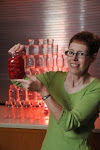Children Serve Themselves More Food When They Use Bigger Dishes
Adult dieters have heard the advice many times – Using smaller plates is a visual cue that helps prevent overeating. But does that principle apply to young children? To find out, DiSantis and colleagues asked first graders to serve themselves a school lunch entrée and side dishes using either small or large plates and bowls. The smaller, child-size plates in this experiment were 7.25 inches in diameter and the small bowls held 8 ounces, while the larger, adult size, dishes were twice as large in surface area/capacity. Half the children used the larger dishes in the first half of the experiment and vice-versa for the other half. Serving spoons and bowls were kept uniform and each child was given a standard portion of milk and bread. After an introductory practice session, each type of food was served twice for both halves of the experiment for a total of eight lunches per child. Researchers also collected demographic data (household size, race/ethnicity, parent’s education/employment, food security), heights and weights, and food-liking scores. Of the 42 children in the study, all were African American or mixed-race/ethnicity, 25 were female and 19 were overweight or obese. Two-thirds (68%) of the parents were employed and 24% were college educated.
When the children used larger dishes they served themselves an average of 90 more calories. The type of entrée was found to be important – children served themselves an average of 239 more calories with larger plates when the food was in pieces (chicken nuggets) vs. amorphous (pasta with sauce). Children also served themselves an average of 104 calories more for foods they rated as “yummy” vs. foods that were rated “yucky or just OK.” The largest differences were found with entrees and similar but smaller differences were observed for fruit. Differences in self-served vegetables were not statistically significant. Body mass index was not a predictor of self-served calorie levels, but food insecurity was a significant predictor (food insecure children served themselves 34% more calories with large dishes vs. 18% with the other children). Although the food insecure children served themselves more food, they did not eat more than the other children. Plate size did not directly predict the amount eaten, but there was an indirect effect of plate size because children who served themselves more food ate more calories at the meal. Specially, for every additional calorie that children served themselves, there was a 0.43 calorie increase in calories eaten.
In addition to internal feelings of hunger, many factors in the food environment affect the amount of food a child eats. For example, the ChooseMyPlate.gov website includes a number of parent/caregiver practices that affect preschoolers’ food environment and help them learn to eat the right amount for their level of hunger:
• Letting children serve themselves and have more later if they are still hungry.
• Avoiding praise for a clean plate.
• Rewarding children with attention and kind words, not food.
• Not being overly restrictive about certain foods.
References:
Disantis KI, LL Birch, A Davey, EL Serrano, J Zhang, Y Bruton, JO Fisher. Plate size and children’s appetite: Effects of larger dishware on self-served portions and intake. Pediatrics. 131(5):e1451-e1458.
Develop healthy eating habits: Help them know when they’ve had enough fact sheet from ChooseMyPlate.gov for Preschoolers (http://www.choosemyplate.gov/preschoolers/healthy-habits/know-when-they-had-enough.html)
By Susan Nitzke, UW-Extension Nutrition Specialist and UW-Madison Professor Emeritus
Wednesday, June 12, 2013
Subscribe to:
Post Comments (Atom)




No comments:
Post a Comment